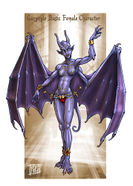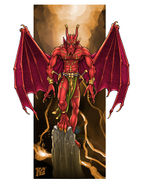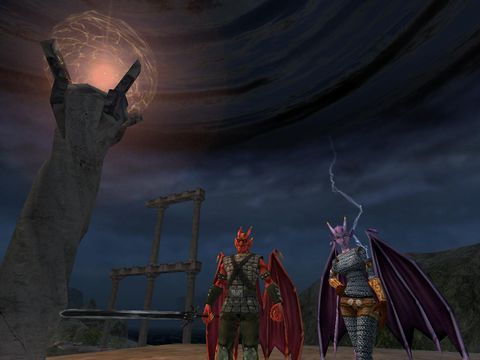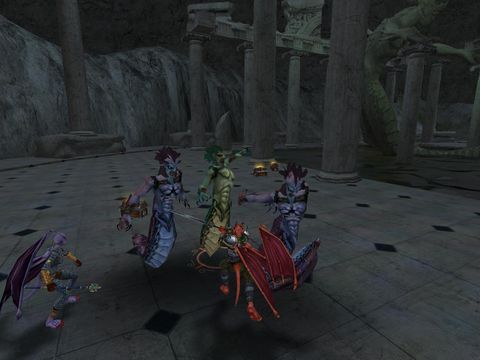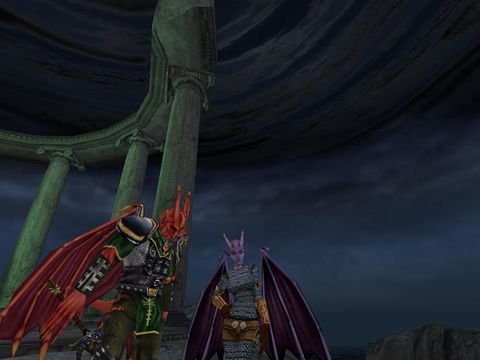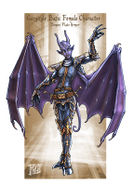Ultima X Gargoyle history
SOURCE: Official Ultima X: Odyssey Website – www.uxo.ea.com
Copied from UXO Stratics
Name: Gargoyle (plural: Gargoyles)
Disposition: Studious and hardworking
Locale: Terfin, high in the mountains of Alucinor
Organization: Small settlements
Physical Description
Gargoyles are slender and about a foot taller than humans, with piercing eyes and a wide variety of skin hues, ranging from deep purples, to blues, to reds. On their hands and feet are sharp, talon-like claws, and grown gargoyles boast large bat-like wings. They cannot fly, but use their wings and tails to ensure a keen sense of balance while fighting. Gargoyles have no hair on their bodies, but will often decorate their skin with painted runes, and their horns are often unique, appearing in various shapes and sizes.History
Book of Prophecy
An ancient prophecy tells of the final days. When the end of our world shall come. Three signs will precede the end. Thrice shall a being of great evil come into our land, and by this it shall be known that the end is nigh. This evil one is of another race, who consider the evil one a great prophet. Yet this false prophet follows not the principles of Control, Passion and Diligence.
One day the false prophet will come and desecrate our most holy shrine. And the false prophet will steal our most holy artifact, the Codex of Ultimate Wisdom. This shall be the first sign of the end. Then, it is written, the false prophet shall descend deep into the bowels of the earth. And the false prophet will cause the underworld to collapse. This will cause great earthquakes to tear our world asunder, and there will be a time of plague and famine. This shall be the second sign of the end.
One last time shall the prophet come. This time, the false prophet will come with a band of warriors. And they will destroy all that remains of the gargoyle race. There is only one way that this prophecy may be averted: That is by the sacrifice of the false prophet.After the celebration and songs about Avatar's ascension and his triumphant victory over the Guardian in Terfin began to subside, the gargoyle scholar Vasagralem found himself with a great deal of time to ponder the manner in which the ancient prophecy had been fulfilled. The gargoyles were gone, destroyed – all save the precious few lucky enough to be outside the walls of the sunken city of Ambrosia when it had collapsed in on itself, killing all those trapped inside.
How had his mighty race fallen to this fate? He had always desired peace, as had his revered predecessor Draxinusom before him. They had read and followed every one of the sacred books, including the Book of Prophecy, which foretold of this very event, and of the Avatar's part in it as the false prophet. But no matter how hard they had tried to steer the hands of Fate, they had failed to avert the prophecy; the event had still come to pass. Everyone Vasagralem had ever known was dead. He now sat, staring at the one thing that could still give his heart hope: a single egg, containing what he could only hope would someday be a new gargoyle queen.
Long Live the Queen
As a race devoid of females for generations, gargoyles had very little concept of feminity or sex, and most considered themselves genderless. It was known through the Book of Family that gargoyles were hatched from eggs, but what was not common knowledge among gargoyles — and certainly not known by outsiders — was that a female gargoyle did actually exist. One single queen, who had remained guarded in a secret lair under the island of Ambrosia for more generations than any gargoyle alive — save the queen herself — could remember. Even after the gargoyles retreated from the humans and re-established Ambrosia on the ocean floor, she remained hidden away from most of her own race, producing eggs that would hatch into fertile winged and wingless gargoyles. All gargoyles were capable of producing eggs, but only eggs that came directly from the queen would yield a gargoyle capable of producing his own offspring later in life. This meant that every other generation had to come from the queen herself, or the gargoyles would eventually die out. This was considered by most learned gargoyles to be quite the Achilles' heel, since it was clear that there were humans who would gladly take the opportunity to ensure the end of the gargoyle race. Thus Queen Zhah, who had been queen for over seven full generations, had been guarded and cared for in absolute secrecy.
Long before the Guardian's dark columns had begun to tear through Britannia, corrupting Ambrosia with a crippling sense of false pride, the ruthless and proud Zhah had taken her own steps to ensure her place as the sole queen. Every generation, Zhah produced hundreds of eggs, but only three or four of each generation were female — and female eggs could only come from a female. By hiding and destroying those few eggs, Zhah believed she was safeguarding her rightful place in gargoyle society. In truth, she was cementing the precarious situation of the gargoyle race — a fact made all too clear when she herself was killed in the destruction of Ambrosia.
The Dominance of Winged: A Lesson in Gargoyle Genetics
Another sacred writing, the Book of Administration, states that for countless ages, there have been both winged and wingless gargoyles, each of equal importance to gargoyle culture. As the dominant of the two, the winged gargoyles are well-known to be more agile and intelligent than the wingless, but not as commonly understood is the fact that the winged gene itself is dominant over the wingless version, meaning that without a constant influx of wingless blood, the gargoyle race might have grown to be entirely winged. The few privileged gargoyles who understood this knew that in order to maintain the dual nature of gargoyles, it was crucial that the queen be wingless herself, thus ensuring that through her direct descendants, winged and wingless gargoyles would both continue to exist.
Age of the Winged
In the weeks following Ambrosia's collapse, Vasagralem devoted all his attentions toward a single cause: the safety of the female egg he guarded. At last, the egg hatched, revealing a sight Vasagralem had never expected to see: the new female had wings! In Vasagralem's studies, he'd learned that it was the queen's wingless status that had ensured the survival of wingless gargoyles, but since Zhah had been queen long before he'd been born, he had not realized until now that females could be born winged. The implications of this were unmistakable: in time, the gargoyle race could be rebuilt, but there would be no more born without wings.
Vasagralem's Decision and the Introduction of the Airemani
In the young female's first days, Vasagralem was faced with a decision. Would he follow in the steps of history, raising her as a single queen hidden from even gargoyle society for her own protection? It didn't take long for him to conclude that he was left with only one real choice: if the race were to survive, more females would be needed, and they would need to be a part of the rebuilding process themselves. As he still looked to the young child as royalty, he debated on how she should be addressed. She should not be a queen, since that position had typically been a single female shrouded in secrecy. His final decision was that this female, and any other females she produced, would hold a new position in gargoyle society, which he called “ai-re-mani,” translated literally as “there will be life.” As the first of the new line of airemani, he dubbed the young winged female “Pri-mani,” or “first life.”
Primani grew at a rate nearly twice that of gargoyle males, surprising Vasagralem with her rapid maturation. Zhah had been hundreds of years old before Vasagralem had been born, which meant he had no knowledge of the life cycle of gargoyle females, save that their lifespan was exponentially longer than that of males. To his relief, it seemed it might not be long before she would be able to begin creating new gargoyles, each of whom would be capable of producing their own offspring. However, he worried greatly, because despite the absence of the Guardian, there were still remnants of the racial hatred that had plagued gargoyle-human relations for so many years, and he was fully aware that his failure to keep her safe would mean the end for them all. But, he reminded himself, his success would mean a new life for the gargoyles.
Reinterpreting of the Book of Prophecy
How did this fit within the Book of Prophecy? Could it be possible that there was yet another catastrophe waiting to occur? He had assumed that the destruction of Ambrosia had been the fulfillment of the prophecy, but if he were to succeed, that would seem to fly in the face of the doom spelled out in the ancient book.
The race had not been fully destroyed, which left only three options: (1) the prophecy was wrong; (2) the Avatar had not been the false prophet after all; or (3) they had somehow managed to circumvent their own end. The first option distressed Vasagralem far too much to give serious consideration, as his entire life had been devoted to following the sacred books. The second option did not seem to be the right one; from the removal of the Codex, to the earthquakes and tremors that occurred when the Avatar had collapsed the Underworld, to the bloody War of the False Prophet, there were simply too many correlations to ignore. Which left the third option — that somehow, they had successfully averted the destruction of the gargoyle race. But according to the prophecy, that could only have happened through the sacrifice of the Avatar!
The realization struck him like a thunderbolt. As far back as he could remember, the gargoyles had believed that the way to avert destruction was to force the sacrifice of the false prophet, and so they had tried for years to see him killed. But what none had understood until that very moment was that it was the willing sacrifice of the false prophet that would be the key. The Avatar, in his final act in Britannia, sacrificed his corporeal self to defeat the Guardian, and it was that act that Vasagralem now believed was the key to their survival of the race. By enabling the single female egg to be safely transported from the collapsing city of Ambrosia and delivering it into the hands of Vasagralem, the Avatar had taken the first step, but how did the Avatar's sacrifice tie in? The gargoyle was convinced that there was a connection.
During the days, Vasagralem devoted himself to teaching and raising Primani, enthralled by how different she was from all the gargoyles he had known. During his nights, he agonized over his studies. He had fully examined and re-examined every word, every phrase of the prophecy, looking for the tie between the Avatar's sacrifice and the survival of his race — a tie he didn't understand, but knew in his heart was there.
A Twisted Land
Far from where Vasagralem was reaching out for an answer, the Avatar was still in the process of creating the land of Alucinor. His thoughts were not so far from where Vasagralem's were, however; he had witnessed tragedy in his time in Britannia, but the destruction of Ambrosia continued to haunt him like few other events. The gargoyles had never fully trusted him, and he couldn't blame them. They had fully believed he would some day destroy their world, and they'd been right. He knew that he'd had no choice in the matter — that it was the corruption of the Guardian's column that had been the real cause for the collapse — but it didn't help ease his sense of remorse. He'd taken a thriving race and left them with little more than a single egg.
As his own new world took form, influenced and shaped by his thoughts, he composed a new version of Ambrosia, complete with the gargoyles he had come to know and respect. But around this area, where there was guilt and unrest in the Avatar's mind, the very fabric of Alucinor was agitated and uneasy.
Sensing this weakness in the Avatar's mental barriers, the Guardian acted quickly. Drawing on his own memories of Ambrosia, he exerted his will and created a rift, twisting the beautiful city into a dark and chaotic place of evil, bearing little resemblance to its namesake. Through the rift, the Guardian also brought forth the Kraken, a creature of unthinkable horror and cruelty who immediately seized the souls of the gargoyles that the Avatar had established there. Unable to penetrate the Guardian's rift due to his own mental unrest, the Avatar watched sadly as the Kraken fashioned those poor souls into an army of undead gargoyles that would threaten all who entered the Guardian's perverted and twisted landscape.
Contacting a God
The Avatar knew that his guilt over Ambrosia was a weakness, and was determined to resolve the disquiet he felt. He turned away from the twisted remains of his own Ambrosia, and concentrated instead on finding a way to help the gargoyles who remained in Britannia. Expecting to encounter only resentment, the Avatar was taken aback when he opened his thoughts to those on Britannia to hear Vasagralem fervently pleading for his help.
Upon learning of Vasagralem's fears, he knew immediately that he could provide what they sought. What Vasagralem needed was a sanctuary; a place where he and Primani could be safe from racial hatred while they produced and raised enough young gargoyles to ensure the survival of the race. Sensing that the Guardian was still immersed in his own savagery on the former Ambrosia of Alucinor, the Avatar quickly extended an offer of protection to Vasagralem and Primani should they wish to join him and become the first travelers from Britannia to settle in his new world.
A Prophecy Fulfilled
With the confirmation of the Avatar's continued existence and the invitation to Alucinor, the aging Vasagralem at last fully understood. The answer that had eluded his people for so long had been clearly visible in the prophecy itself.
There is only one way that this prophecy may be averted: That is by the sacrifice of the false prophet.
It had been Sacrifice all along. By practicing the Virtue of Sacrifice, the false prophet had not only placed himself in danger to save a female egg, but had ultimately created the new world where the gargoyles could escape destruction, thus averting the final days of the gargoyles. A small difference in interpretation, almost resulting in the self-destruction of an entire species.
They had desperately feared this false prophet, who according to the Book of Prophecy would not follow their principles of Control, Passion and Diligence. This fear, passed on for generations, fostered an intense distrust of the Virtues and those who followed them, ensuring that their desire for unity and order could never truly be realized. How could unity possibly be achieved with constant strife between the peoples of the land?
Given a blank slate, Vasagralem realized that it was up to him to be the great thinker of his time; that like Naxatilor, the great seer of long ago, the direction of the gargoyles was now his to set. He was reaching the end of his years, but it was imperative to see that the gargoyles learned from the mistakes of their past.
The gargoyle principles of Control, Passion and Diligence would continue to be taught as the way to achieve Order, but gargoyles would be free, and even encouraged, to follow the example of the Avatar and pursue the Virtues. By learning about both sets of values, the gargoyles could be true to their heritage while still embracing the new world, and the Virtues that had opened the door for their survival.
Organization
Gargoyles live in somewhat secluded settlements called clans, and gargoyle society is governed by strict rules. Study of the Virtues is of paramount importance in gargoyle society, as the writings of the great scholar Vasagralem state that it was the Virtues that allowed the gargoyles race to survive and be reestablished in Alucinor.However, the writings of Vasagralem also stress that knowledge of the traditional way of the gargoyles must never be lost, and that unity and singularity must be prominent in all things.
From the Book of the Circles:
All begins with the three principles: Control, Passion and Diligence. From Control springs Direction. From Passion springs Feeling. From Diligence springs Persistence. But these three virtues are no more important than the other five: Control combines with Passion to give Balance. Passion combines with Diligence to yield Achievement. And Diligence joins with Control to provide Precision. The absence of Control, Passion and Diligence is Chaos. Thus the absence of the principles points toward the seventh virtue, Order. The three principles unify to form Singularity. This is the eighth virtue, but it is also the first, because within Singularity can be found all the principles, and thus all the virtues. A circle has no end. It continues forever, with all parts equally important in the success of the whole. Our society is the same. It too continues forever, with all members (and all virtues) equal parts of the unified whole.
In homage to the gargoyle culture of Britannia, young gargoyles are often given names from prominent gargoyles written about in the histories.
Disposition
Gargoyles have been called stoic, but a more accurate description would likely be single-minded. Thanks to a legendary work ethic, gargoyles will focus intently on the task at hand, rarely smiling or laughing until their task or duty is complete.At other times, gargoyles have been known to have a healthy sense of humor, although the ability to laugh at themselves typically does not extend to their devotion to the Virtues or the Principles of Singularity. This system of beliefs is considered quite sacred, and not something to be desecrated through jokes.
Language
"Gargoyle" is an English corruption of gargl, the gargoyles' name for themselves and their language, also informally referred to as "Gargish.”Spoken Gargish is grammatically rather flexible. Distinctions between nouns, adjectives, and verbs are indicated by gestures and intonations. This flexibility is also apparent in the names of magic spells derived from Gargish phrases. "Vas Sanct Lor,” for instance, is derived from the Gargish “vas saengkt lor,” but it is equally correct to say “saengkt vas lor” or even “lor saengkt vas.” Gargoyles tend to omit words they consider to be unnecessary complications, like pronouns, and often speak in infinitives. While a human attempting to speak Gargish might come up with something like “í est ker í le vid ú prae,” (or "I'm certain that I've seen you before”), a gargoyle would simply say “ker le vid prae” (or more idiomatically, “ker prae vid le”), or "to be certain having seen before.” With practice, it's possible to deduce the implied pronouns in a Gargoyle sentence, but it's not always easy.
Unlike spoken Gargish, the written language has no way to mark the intonations and gestures that make the speech intelligible, so there are suffixes that mark words as being verbs, nouns, or adjectives, and also indicate the tense and aspect of verbs.
A more extensive list of word parts and vocabulary can be found at:
http://uxo.stratics.com/content/races/gargoyle_language.php.Combat
Gargoyles like to be prepared for anything they might encounter, and they train every day for combat. If provoked, gargoyles quickly prove to be accomplished and dangerous foes, fighting with the same analytic, measured style that marks their domestic lives. Although their pace may not be quick, gargoyles are precise and effective in their use of weapons and spells.
Gargoyles - Original Description from October 2, 2003
High in the mountains of Alucinor there lives a stoic breed called the gargoyles. These tall, gaunt, winged creatures have a legendary work ethic, and they focus intently on the task at hand, rarely smiling or laughing.
Gargoyles are about a foot taller than humans, although they are thinner and their feet and hands resemble claws. Large bat-like wings also sprout from their backs, and though they cannot fly, they can use the wings for extra propulsion when jumping. Gargoyles have no hair anywhere on their heads though they grow horns of many types and sizes.
Gargoyles live in secluded settlements called clans, where life is focused on the three Gargoyle principles of control, diligence, and passion. Gargoyle society is governed by strict rules, and every member of a clan is expected to work hard for the community. Failure to keep up the pace can result in banishment from the clan. Banished Gargoyles are often the ones that move into the wild and take up a life of adventure, seeing great tracts of Alucinor and sharing their experiences with other races.
Gargoyles like to be prepared for anything they might encounter, and they train every day for combat. If provoked, Gargoyles quickly prove to be accomplished and dangerous foes, fighting with the same analytic, measured style that marks their domestic lives. Although their pace may not be quick, Gargoyles are precise and effective in their use of weapons and spells.
